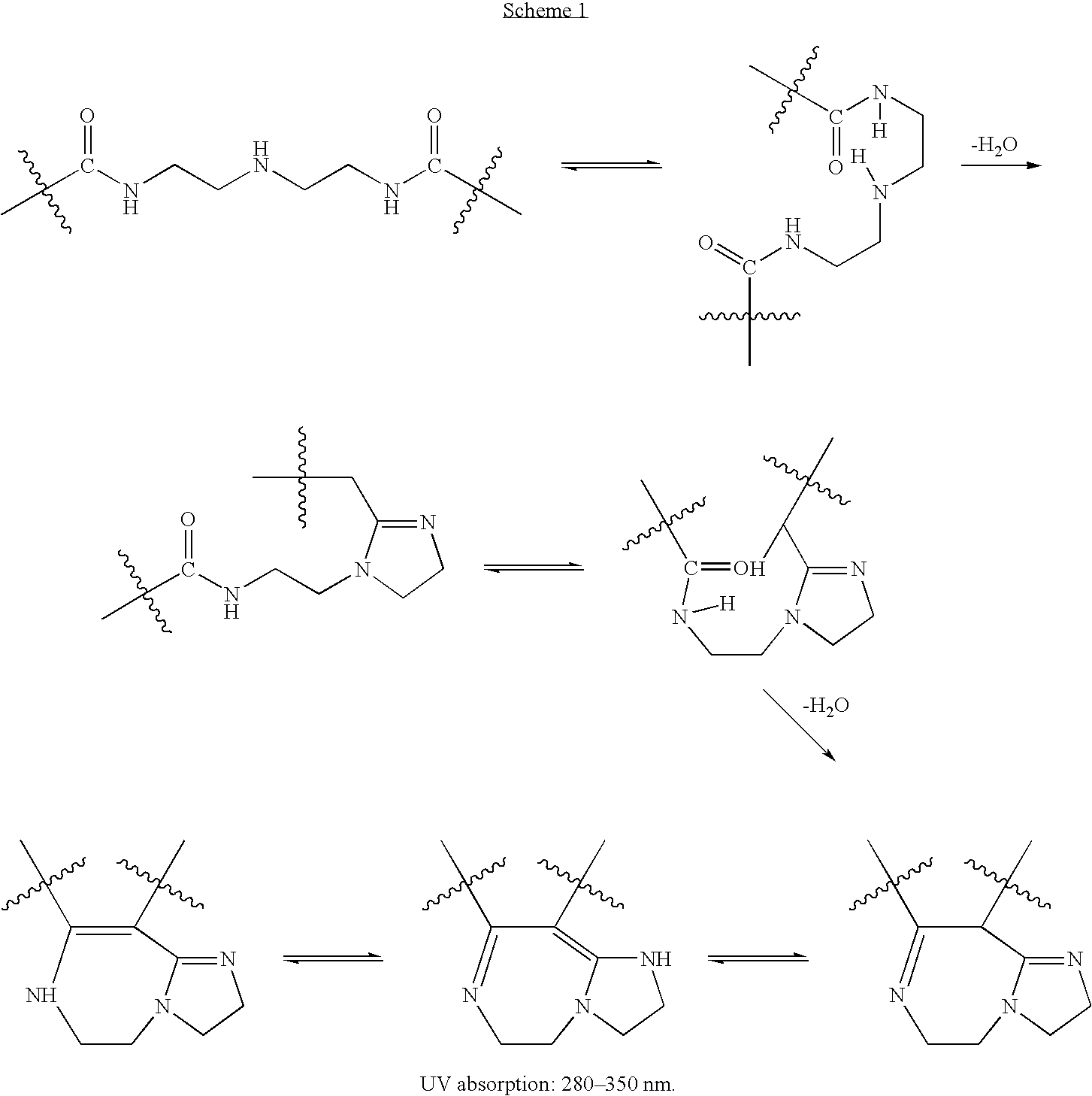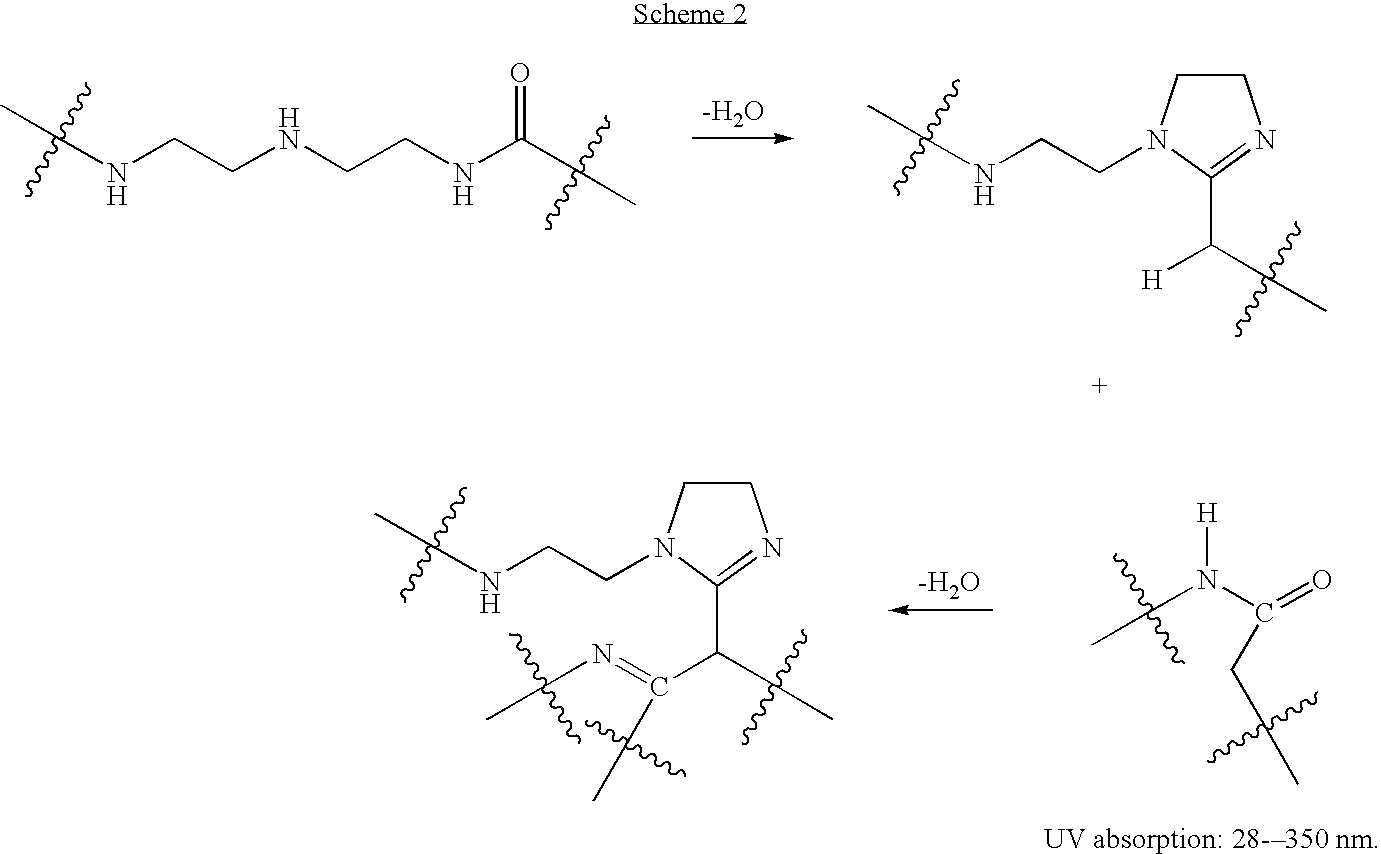Water-soluble polyaminoamides comprising 1,3-diimines as sunscreen agents
a technology of 1,3-diimines and water-soluble polyaminoamides, which is applied in the direction of chemical inhibitors, spectral modifiers, medical preparations, etc., can solve the problems of uv light radiation, damage to human skin, and loss of skin elasticity and wrinkles,
- Summary
- Abstract
- Description
- Claims
- Application Information
AI Technical Summary
Benefits of technology
Problems solved by technology
Method used
Image
Examples
example 1
Diethylenetriamine-DBE-2 Dibasic Ester Polyaminoamide Containing 1,3-diimine Groups.
[0109]In a 5-neck 1000 ml two-piece resin reactor equipped with a mechanical stirrer, nitrogen purge, temperature controller and condenser is charged 208.0 g diethylenetriamine (DETA, 2.0 moles), 327 g (2.0 moles) DBE-2 dibasic ester and 5.0 g sulfuric acid. The mixture is heated to 150° C. and methanol is collected through a condenser. The temperature is raised to 180° C. once no additional methanol is distilled out. The temperature is maintained at at least 180° C. for several hours until about 15.0 g of byproduct water is collected. Heating is then stopped and 395 g water is slowly added into the reactor at a temperature below about 140° C. to make an aqueous polymer solution.
example 2
Diethylenetriamine-Dimethyl Terephthalate-DBE-2 Dibasic Ester Polyaminoamide Containing 1,3-diimine groups.
[0110]To a reactor as described in Example 1 is charged 87.3 g (0.45 mole) dimethyl terephthalate and the reactor is purged with nitrogen for 15 minutes. DETA (156.4 g, 1.5 moles), DBE-2 dibasic ester and 5.0 g sulfuric acid are charged into the reactor. The mixture is heated at 150° C. for about 2 hours until no methanol is distilled off. The temperature is then raised to 190° C. The temperature is kept at 190° C. or higher for several hours until about 15.0 g of byproduct water is collected. Heating is then stopped and 300 g water is slowly added into the reactor at a temperature below about 140° C. to make an aqueous polymer solution.
example 3
Diethylenetriamine-Dimethyl Terephthalate-DBE-2 Dibasic Ester-Methyl Salicylate Polyaminoamide Containing 1,3-diimine Groups.
[0111]To a reactor as described in Example 1 is charged 58.3 g (0.3 mole) dimethyl terephthalate and the reactor is purged with nitrogen for 15 minutes. DETA (171.6 g, 1.65 moles), 196.2 g (1.2 moles) DBE-2 dibasic ester, and 5.0 g sulfuric acid are charged into the reactor. The mixture is heated at 150° C. until no methanol is distilled off. Methyl salicylate 45.3 g (0.3 mole) is added into the reactor. The mixture is further heated at 150° C. until no methanol is distilled off. The temperature is then raised to 190° C. and maintained at 190° C. or higher until about 15 g of byproduct water is collected. Heating is then stopped and 300 g water is slowly added into the reactor at a temperature below about 140° C. to make an aqueous polymer solution.
PUM
| Property | Measurement | Unit |
|---|---|---|
| wavelength | aaaaa | aaaaa |
| wavelength | aaaaa | aaaaa |
| temperatures | aaaaa | aaaaa |
Abstract
Description
Claims
Application Information
 Login to View More
Login to View More - R&D
- Intellectual Property
- Life Sciences
- Materials
- Tech Scout
- Unparalleled Data Quality
- Higher Quality Content
- 60% Fewer Hallucinations
Browse by: Latest US Patents, China's latest patents, Technical Efficacy Thesaurus, Application Domain, Technology Topic, Popular Technical Reports.
© 2025 PatSnap. All rights reserved.Legal|Privacy policy|Modern Slavery Act Transparency Statement|Sitemap|About US| Contact US: help@patsnap.com



